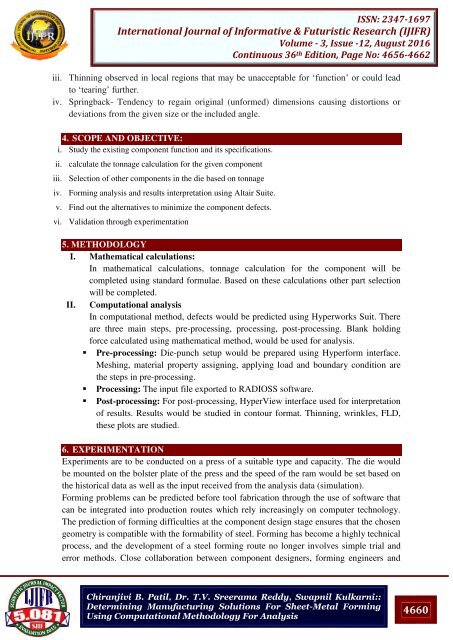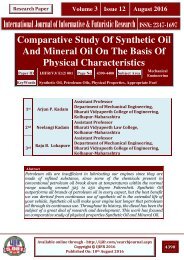IJIFR VOLUME 3 ISSUE 12 AUGUST 2016
RESEARCH PAPER
RESEARCH PAPER
You also want an ePaper? Increase the reach of your titles
YUMPU automatically turns print PDFs into web optimized ePapers that Google loves.
ISSN: 2347-1697<br />
International Journal of Informative & Futuristic Research (<strong>IJIFR</strong>)<br />
Volume - 3, Issue -<strong>12</strong>, August <strong>2016</strong><br />
Continuous 36 th Edition, Page No: 4656-4662<br />
iii. Thinning observed in local regions that may be unacceptable for ‘function’ or could lead<br />
to ‘tearing’ further.<br />
iv. Springback- Tendency to regain original (unformed) dimensions causing distortions or<br />
deviations from the given size or the included angle.<br />
4. SCOPE AND OBJECTIVE:<br />
i. Study the existing component function and its specifications.<br />
ii. calculate the tonnage calculation for the given component<br />
iii. Selection of other components in the die based on tonnage<br />
iv. Forming analysis and results interpretation using Altair Suite.<br />
v. Find out the alternatives to minimize the component defects.<br />
vi. Validation through experimentation<br />
5. METHODOLOGY<br />
I. Mathematical calculations:<br />
In mathematical calculations, tonnage calculation for the component will be<br />
completed using standard formulae. Based on these calculations other part selection<br />
will be completed.<br />
II. Computational analysis<br />
In computational method, defects would be predicted using Hyperworks Suit. There<br />
are three main steps, pre-processing, processing, post-processing. Blank holding<br />
force calculated using mathematical method, would be used for analysis.<br />
• Pre-processing: Die-punch setup would be prepared using Hyperform interface.<br />
Meshing, material property assigning, applying load and boundary condition are<br />
the steps in pre-processing.<br />
• Processing: The input file exported to RADIOSS software.<br />
• Post-processing: For post-processing, HyperView interface used for interpretation<br />
of results. Results would be studied in contour format. Thinning, wrinkles, FLD,<br />
these plots are studied.<br />
6. EXPERIMENTATION<br />
Experiments are to be conducted on a press of a suitable type and capacity. The die would<br />
be mounted on the bolster plate of the press and the speed of the ram would be set based on<br />
the historical data as well as the input received from the analysis data (simulation).<br />
Forming problems can be predicted before tool fabrication through the use of software that<br />
can be integrated into production routes which rely increasingly on computer technology.<br />
The prediction of forming difficulties at the component design stage ensures that the chosen<br />
geometry is compatible with the formability of steel. Forming has become a highly technical<br />
process, and the development of a steel forming route no longer involves simple trial and<br />
error methods. Close collaboration between component designers, forming engineers and<br />
Chiranjivi B. Patil, Dr. T.V. Sreerama Reddy, Swapnil Kulkarni::<br />
Determining Manufacturing Solutions For Sheet-Metal Forming<br />
Using Computational Methodology For Analysis<br />
4660



